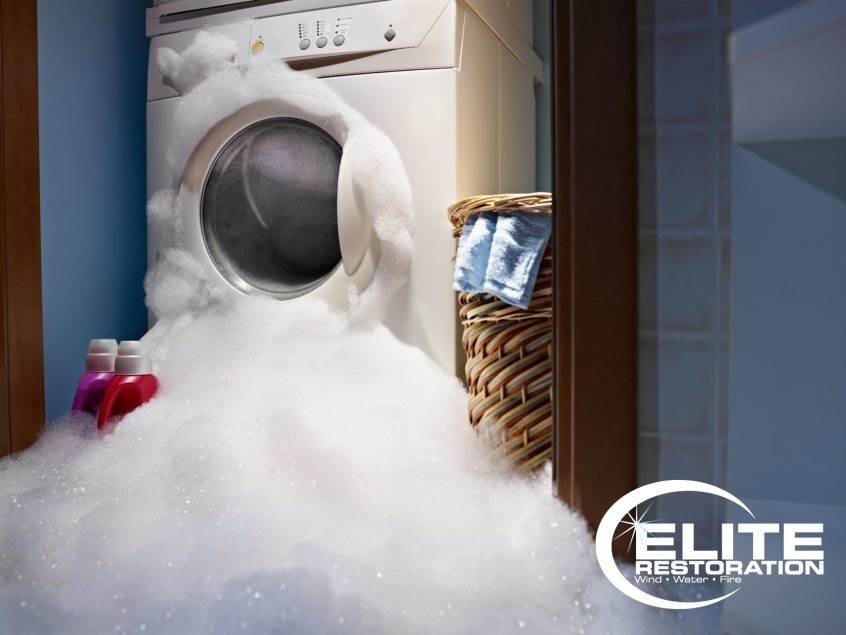Cause of Washer Leaks and How to Fix Them

Why Is My Washing Machine Leaking?
Remember that old prank call kids used to make where they’d ask if someone’s refrigerator was running, and when the person responded yes, they’d abruptly laugh into the phone, “well, you better go catch it?”
Good times.
But while a running appliance is a good thing, finding a puddle in your laundry room is not. Water by your washer means there’s a leak. It could be a small and easily repairable one; it could be major. Every leak needs to be investigated and repaired before the puddle becomes a flood, or before you assume all is lost and spend $800 on a new one!
What causes leaks in washing machines? More specifically, what kinds of leaks appear in what kinds of washers?
Top-Load Washer Leaks
Overflow Tube Leak
If you have a leak at the front of your top-loading washer, this usually means you have a clogged or tilted overflow tube. This can happen from using too much detergent or incorrectly combining laundry products. If your home has soft water, keep in mind that less detergent is needed for cleaning. If you want to test whether you’re using too much detergent, simply take a freshly washed item and put it in a bowl of hot water before putting it in the dryer. Does the water gets soapy? That means you’re using too much.
Also, make sure to not overload your washer or sit it off balance. Make sure your machine is level on the ground, try reducing your load sizes, and watch to see if the leak returns. You may have solved the problem.
If your top-load washer is new, a leak in the back of it may just mean you didn’t remove the manufacturer’s drain plug before installing the drain hose, so check this first. Remove the hose and you’ll find a plastic plug. Have a bucket and towels ready to catch the excess water, then remove the plug and throw it away.
Drain Hose Leak
A leak at the back of a top-loading washer can also be the result of a drain hose that wasn’t properly secured in the drainpipe. Be sure that the hose is fully inserted into the drainpipe. If the leak persists around the drainpipe, especially during the spin cycle, then you’re probably dealing with a clogged drainpipe and this clog is not allowing water to move down the pipe, thus backing it up and causing an overflow.
One final reason for a leak at the back of your top loader is the fill hoses are too not connected well enough. Turn off the water supply, remove the hoses, and then check to see if the rubber washers are in working condition…or if they’re even there, as some manufacturers may skip this. Replace the hoses and hand-tighten the connections. However, if there’s still a leak, you’ll want to replace the hoses, as this might mean there’s a pinhole-sized leak that could soon burst!
If your washer’s leak is coming from underneath it, this probably means there’s a hole in the water pump and that it should be replaced immediately to prevent water from falling directly on the motor. If you feel comfortable doing it yourself, simply grab the repair manual for your washer model (or find one online) and purchase the replacement parts.
Front-Load Washer Leaks
If you don’t regularly clean out the door seal on a front loader of soap and debris, it will eventually begin to leak. Clean the gasket weekly, paying attention to the edges. Be sure to check the seal, checking for punctures or trapped items.
If the door is not closing all the way, this will also lead to leaks. Make sure the hinges are properly installed, and if not, readjust them so that the alignment is correct.
When it comes to leaks in the back of a front loader, the same problems a top-loader faces apply. Simply follow the tips listed above to identify and repair the leaks. And just like with top-loaders, too many suds can lead to overflow, so always use a small amount of HE detergent in a front loader.
Finally, if your front-load washer has a leak underneath it, there’s a good chance the bolt seams on the outer drum have begun to leak. In this case, you will need to repair or replace the seams.
One final note. If your washer is overflowing (and excess suds are not causing it), you’ll want to repair this problem as soon as possible, as a water valve or pressure switch usually causes the problem.
Hopefully these suggestions above can answer your question: “why is my washing machine leaking?”. If not, it may be time to call a trusted professional to help!

